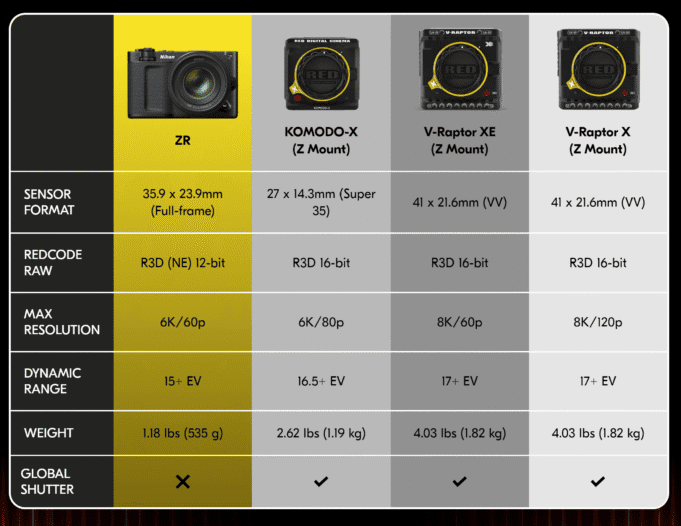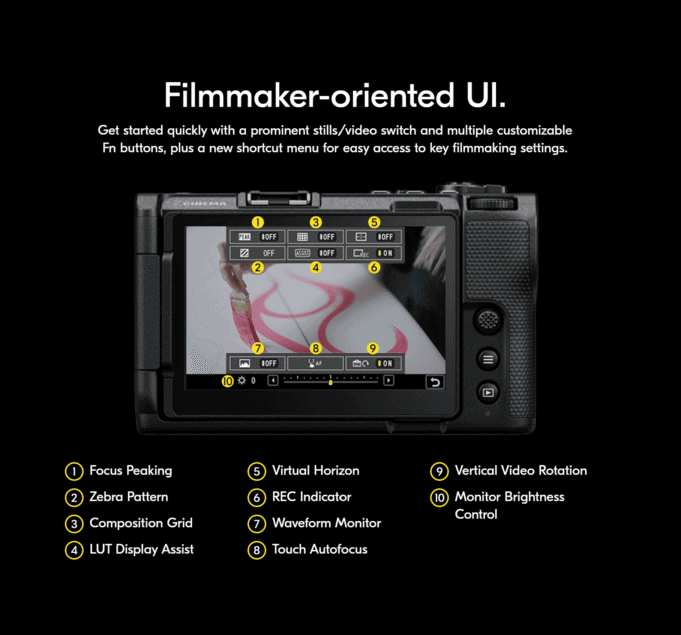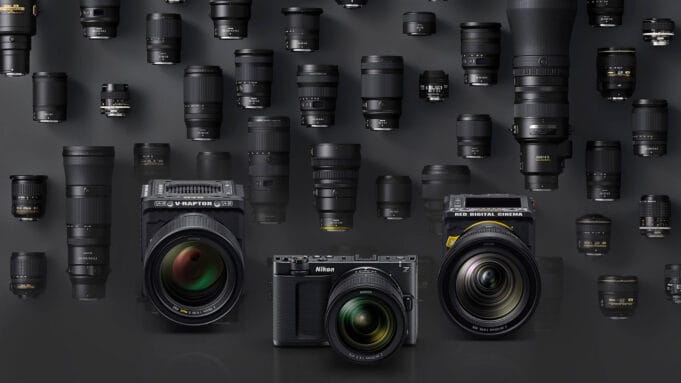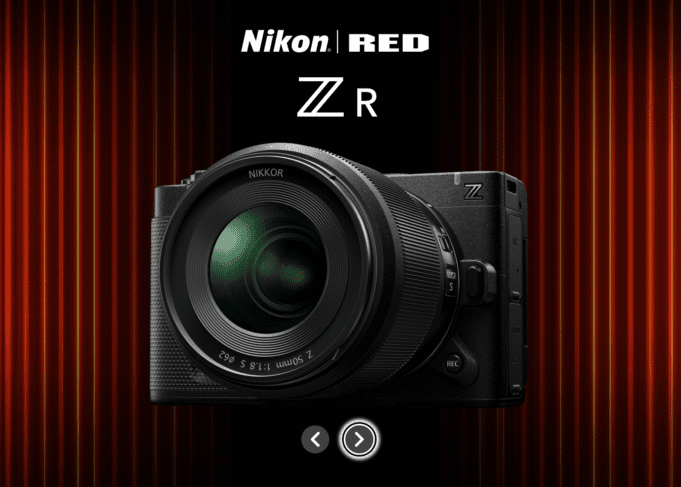The Canadian boys in the woods (PetaPixel) call it the “ZED RED” which I kind of like.
Nikon officially calls it the ZR: as in the new Nikon RED ZR to be exact.
And it might just be the best and most surprising cinema camera in recent years. Firstly, because of most of us thought that the RED Digital Camera brand and the innovation along with it would mostly die post Nikon acquisition. And, that also, who on earth believed Nikon would price this compact 6K video camera that records to REDCODE for only $2,200 USD?!
That is remarkable.
Nikon ZR Undercuts the Competition… Significantly
Consider its main competitor, the well regarded Sony FX3. It sells for $4,100. 86% more expensive!
And then there’s the new Canon EOS C50 which also dropped this week and seems to be well received by YouTubers, influencers and bloggers alike. That retails for $3,899.
Both the FX3 and C50, in my estimation at least, are actually fairly priced. The new ZR, on the other hand, can only be described as a ballsy play by Nikon. No doubt, this is not just a product, it’s a statement. Nikon is saying it is serious about the world of cinema and is ready to play. To reinforce that premise, the company have also introduced this unifying marketechture bringing the new ZR along with the exiting RED camera line-up (all existed before the acquisition) under a new umbrella, “Z Cinema”:

Companies do this all the time of course. Apple comes to mind where you can compare specs and features across, say, new iPhone models (yours is fine, no need to upgrade!).
But did I mention, this is Nikon. This is supposed to be an ancient, stodgy and slow old Japanese Company. And, yet, here they are really making waves in the world of cinema. Not a bad way to introduce their first Nikon/RED branded product.
What Boxes Does the ZR Tick?

In terms of my checklist, the Nikon ZR pretty much checks them all — just like the C50 does, which I also wrote about here on Stark Insider. Since I already own a RED Dragon, I was looking for a complementary compact travel partner. While I had high hopes, the Panasonic GH6 image quality never quite satiated my desire for an organic, film-like aesthetic. The Dragon sensor, meanwhile, knocks it out of the park when it comes to that beautiful filmic look.
So here’s the features that I think are important in the ZR for my use case:
- 6K/60 and 4K/120 resolution/fps options (plenty of flexibility)
- CFexpress Type B media (inexpensive, robust, fast)
- Lightweight at only 1.2 pounds
- Articulating, 4-inch monitor (might not need an external monitor in many situations thanks to the large size)
- 32-bit floating audio (greatly reduces chances of clipping)
- 15-stops dynamic range (per Nikon, usually these come in lower, nevertheless if its like traditional RED cameras it should be quite good)
- Dual base ISO (800/6400)
- IBIS (bonus!)
All of this alone would be considered outstanding for $2,200 in the world of cinema cameras.
But the one feature that puts the Nikon ZR over the top, and makes me reconsider a Canon C50 pre-order is…
REDCODE! REDCODE! REDCODE!

Yes, when it comes to video editing, REDCODE is my favorite codec. I appreciate that it’s like a form of digital Play-Doh. I can push and pull image settings like exposure, black levels, grain, saturation, color wheels, etc. in Premiere Pro without breaking the footage. R3D files seem to have industrial strength algorithms. Basically, magic. I should also mention the performance when scrubbing: butter smooth. Again, I don’t know the reason, but jumping around on a timeline, dragging clips, scrubbing and doing all the things editors do seems so silky smooth with REDCODE footage. The same can’t be said for so many others.
So with REDCODE on board, the ZR, already showing well with its base specs, becomes almost too good to be true.
Granted, this version of REDCODE is a special, non-flagship variation from what I can tell. Nikon dubs it R3D NE. From the tech specs you’ll notice that it’s “only” 12-bit vs. the 16-bit version you get out of the higher end cameras in the line-up. I think that’s a perfectly fine trade-off for getting a package this compact and light. For large scale RED productions, the ZR will likely become a no-brainer crash cam, or a drone cam, or a place-anywhere cam that can intercut well within the ecosystem.
But… There’s a Showstopper?

However, this being Nikon means the new ZR uses the Z mount. No surprises there. The entire Nikon RED line-up now uses the ubiquitous mount. This may cause some pause.
In my case, I’m a lifelong Canon guy. So I have a lot of EF/EF-S glass. There’s no way I’m going to eBay all that and replace it with pricey, larger Nikon lenses. Sony shooters might feel the same.
What to do?
Maybe the C50 with its native RF mount (and EF adapter) is the better choice after all?
Yes and no. The native RF mount will pass through all the electronics and auto-focus well enough and perform almost as well as native RF. That’s compelling, and means essentially the mount is a non-factor when it comes to considering the C50.
Thankfully, though, I’ve learned, thanks to ChatGPT and Claude, that the Z-mount is particularly well suited to adapting. I quickly checked Amazon and found several Z-EF adapters. Many inexpensive ones are passive, which suits me fine as I’m using this for short films, experimental stuff and scenarios where I have time to use manual focus, adjust lighting, etc. For many run-and-gun, wedding shooters, live event shooters this will not suffice. They will need to either go native Z mount, or stick with Sony. Or look at the new C50 which is pretty slick.
REDCODE + Log3G10 in my situation anchors my decision squarely: the Nikon ZR is the clear choice. The fact that it’s so much cheaper than the C50 means I can toss in a 50mm kit lens and still save a bunch, and have at least one native Z mount lens when I absolutely need AF.
Nike Has Entered the Room in Style
All said and done, this is quite an entrance. Nikon seems to be creating quite a stir among us holdouts who prefer not to shoot on iPhones and appreciate old school cameras. A quick scan across YouTube, Reddit, Newsshooter (NIKON ZR– the company’s first digital cinema camera), and forums reveal that, yes, many appear to agree that this is a significant milestone for the industry.
Blackmagic Design is/was the predominant player in this price range. Now I wonder what sort of impact that will have on its product line. CEO Grant Petty announced the company will now support Apple’s emerging ProRes RAW codec which could be a move to help give the line-up increased platform support, and beefier workflow options for professional productions. (tip: load up on memory cards, ProRes RAW files are huge).
A final note regarding Nikon’s announcement relates to accessories. The Nikon ZR already has several on the way, including cages by SmallRig, a shotgun microphone that sits on the hot shoe (ME-D10 $340) and a really cool looking add-on grip (MC-N10 Grip $492) that reminds me very much of the side handle on my Scarlet-W. Obviously, the ZR was not rushed to market, and all of these things were considered as part of the product launch.
So, yes, the Canon C50 does tick all the right boxes.
It’s just that the Nikon ZR does as well, and it checks one really important one that no one else can match: REDCODE. And that’s the tipping point for me.
The Nikon ZR is now available for pre-order.
Kudos: To the Nikon marketing team for the Twin Peaks inspired red drapes on the Nikon ZR web page. 🎬


